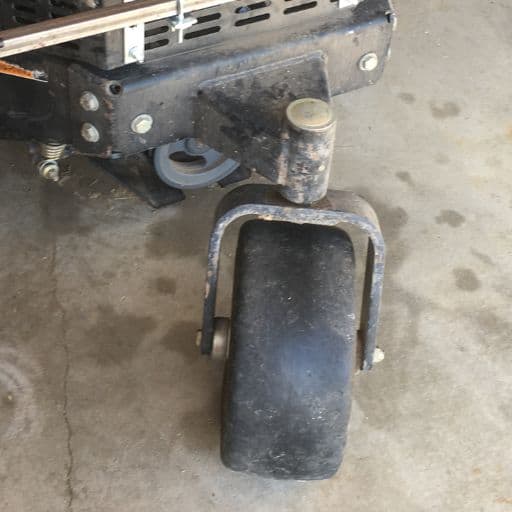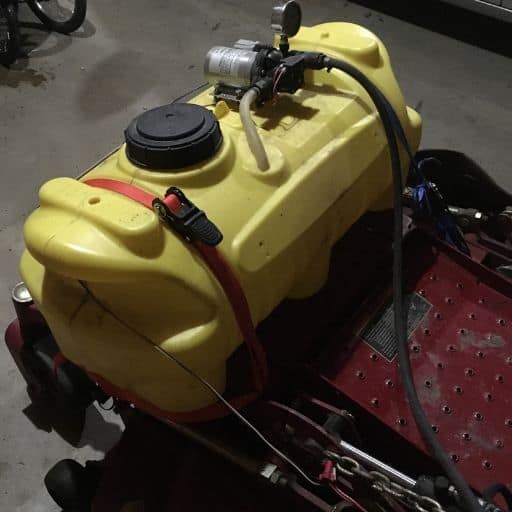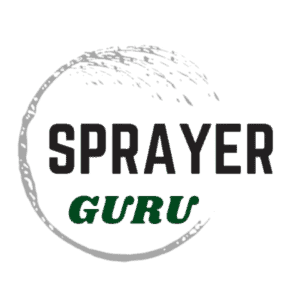Zero-turn mowers have become very popular and many people have replaced their traditional lawn tractors in favor of a more maneuvrable zero-turn option. Individuals who used their lawn tractor to pull a sprayer may be asking themselves can I pull a sprayer with my zero-turn mower? This is the situation I found myself in and here Is what I was able to find out.
In most cases, you can pull a small boom sprayer behind a zero-turn mower, but there are situations where it would not be advised. Your mower’s ability to tow a sprayer will depend on several factors including the mower towing capacity, the weight of your sprayer, and environmental conditions (weather, terrain, etc.).
Let’s take a look at the different types of zero-turn mowers, the weight they can tow, and the different accessories available to make it possible to use a sprayer with a zero-turn mower.
RELATED: Building a Sprayer Boom
Can Your Mower Handle the Weight?
The first factor to consider is the towing capacity of your mower. Towing capacity is not as simple as how much horsepower your engine produces. How much you can actually tow or pull will vary depending on several variables including the mower’s weight, tire tread, surface type, weight on the hitch, etc.
Specific towing capacity can vary depending on the manufacturer and model of your mower. Some manufacturers warn that if your mower does not come with a hitch it is not intended to be used as a towing vehicle. You can always refer to your manual or contact the manufacturer for this information. Do note that there is a difference between tongue weight and tow weight. Towing weight is the weight of a wheeled object that can be pulled, but tongue weight is the actual weight pushing down on the hitch of the mower.

I reached out to the manufacturer to find out what the towing capacity is on my Exmark zero-turn mower. They explained to me that they actually do not publish specific towing weights for their mowers. However, they did explain the guideline for their machines: If you cannot pull the item by hand, then you should not tow it with one of their mowers.
Furthermore, they also suggest that if you do tow anything with your zero-turn mower, you should change the oil and filters in your hydro system more often due to the added stress. Instead of changing the oil every 250 hours, it would be beneficial to instead change it at 200 hours.
I also reached out to several other manufacturers to see the towing capacity of popular models. The chart below shows the responses I received.
Towing Capacity of Popular Models
| Make & Model | Maximum Towing Capacity (lbs) |
|---|---|
| Troy-Bilt Mustang Z54 | 330 |
| Ryobi RYRM8034 (Electric) | 500 |
| Cub Cadet ZT1 | 250 |
| Kubota Z231BR | 250 |
| John Deere Z515E | 250 |
Sprayer Weight
The second aspect of deciding whether or not your mower can tow a sprayer is the loaded weight of your sprayer. To determine the weight of your sprayer you probably need to refer to the factory or to the user manual to find that information. A typical 25-gallon tow behind sprayer generally weighs anywhere from 50-60 pounds when empty. This varies on the boom size, heaviness of the frame, tire size, etc.
Obviously, your sprayer will weigh more when it is full than empty. To calculate the weight of your loaded sprayer, you need to know the capacity of the tank. Water weighs 8.35 pounds so a 25-gallon sprayer tank can weigh over 200 pounds when filled. This means a completely fill 25-gallon sprayer would potentially weigh 250+ pounds.
Here is the empty weight of some popular pull-behind sprayers. A mower will need a towing capacity of at least 250 pounds to safely tow a 25-gallon sprayer. For a larger sprayer like the 41-gallon capacity sprayer shown in the chart below, the towing capacity will need to be nearly 500 lbs.
Other Factors
Towing capacity and weight are the primary things to consider, but these are not the only things that will affect your zero-turn mower’s ability to tow a sprayer. Weather conditions, terrain, slope, and mower design will also affect whether you can tow a sprayer behind your mower.
Terrain
You might find that your mower is rated for the weight of your sprayer, but what if the conditions are not ideal? Steep inclines and rough surfaces can drastically decrease what you can tow. If you have ever pushed a wheel barrel or pulled a wagon up a hill vs across a flat field, then you understand how much more force is required to climb a hill. If you have a very hilly property or a steep slope you want to spray, you might want to consider another method of application. It can be hard on the mower and a safety hazard.
Weather
The weather itself won’t necessarily affect what you can tow, but the muddy ground can be harder to pull a heavy sprayer across. Frozen ground or slick surfaces will greatly increase your stopping distance as well.
Mower Design
Another issue that may affect whether or not your zero-turn mower can tow a sprayer is the design of your mower. Many zero-turn mowers are not built with towing equipment in mind. Therefore, many have no hitch, and in the case of the zero-turn mower I have used for years, there is a wheel in the back center that makes it nearly impossible to attach an aftermarket hitch. Even a custom solution would require more elaborate changes to my machine than I care to implement.

In my scenario, I opted to mount a sprayer on the front of my mower and install a small boom on the rear. You can see more on this below.
How to Tow a Sprayer With a Zero-Turn Mower?
One of the main hurdles preventing you from towing a sprayer with a zero-turn mower is the absence of a hitch. Even if you have determined that your mower can handle the weight of your fully-loaded sprayer, you may not have a way to connect it to your mower. The good news is that there are a couple of solutions.
Add a Hitch
The first solution is going to be the simplest. You can find a hitch or bracket that will fit your model of mower. You can see here on Amazon that there are several different choices available. From options to fit specific manufacturers and models, or more universal hitch options that may require you to drill some holes.
Aftermarket Hitch Attachment for Zero-Turn Mowers:

Mounting a Sprayer on a Zero-Turn Mower
With the design of my zero-turn mower. I was unable to use any of the hitches that I could find online. The solution that I settled on was to mount the sprayer tank on the deck and install a small boom on the rear of my mower. I used the exhaust guard to attach a couple of angle brackets. This provided support for a small boom.
The deck is not intended for the full weight of my loaded sprayer tank, so I never fill it full. I also do not mow with the sprayer in place. You can find more details in my post on building a simple sprayer boom.

What If I Tow a Sprayer too Heavy for My Mower?
Zero-turn mowers use a hydrostatic system to drive the wheels. This system is made up of motors, pumps, hoses, filters, hydraulic fluid, etc. If you pull an object that is heavier than the manufacturer recommends, this will put excess strain on the hydrostatic system. This can lead to overheating and eventually permanent damage.
The stability and stopping time of the mower will also be dramatically affected when towing a heavy sprayer. This creates a safety problem in addition to potential mechanical problems. The manufacturers have a recommended towing capacity for a reason and it is best to abide by these guidelines.
Things to Remember
In many cases, you will have no problem pulling a small sprayer (about 25 gallons) with your zero-turn mower. Once you have checked and determined that your machine is capable of towing the weight of your sprayer, there are a few keys to remember.
Towing a sprayer, or any other piece of equipment will change the braking ability of your mower. It is advisable that you drive slowly and avoid any uneven ground. Just like when mowing, it is best to avoid driving along steep inclines. Finally, don’t forget that the boom of your sprayer may stick out farther than the width of your mower. Be mindful to avoid obstacles that can break your boom.

